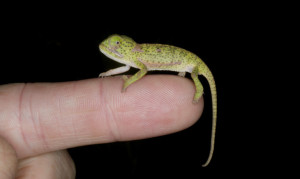
Some of the world’s smallest chameleons have the world’s fastest tongues.
In automotive terms, the tongue could go from 0 to 60 miles per hour in a hundredth of a second, though it only needs about 20 milliseconds to snag a cricket.
Brown University biologist Christopher Anderson wanted to find the upper limit of chameleon tongue performance. To do that, he gathered individuals of 20 species of widely varying sizes in his former University of South Florida lab. Then he perched them one by one in front of a camera that shoots 3,000 frames a second.
For each measurement, a cricket hung off a small dangling mesh to tempt the tongue to emerge. When it did, he could measure the distance the tongue went, the elapsed time, and the speed and the acceleration at any given time.
What Anderson noticed across all his measurements and analysis was that the smaller the chameleon, the higher the peak acceleration, relative power, and distance of tongue extension relative to body size.
Larger chameleons produced impressive motions, too, but not compared to their smaller cousins. For example, a roughly two-foot-long species, Furcifer oustaleti, managed a peak acceleration less than 18 percent that of the tiny champ, Rhampholeon spinosus.
“Smaller species have higher performance than larger species,” says Anderson.
Anderson’s findings, published in Scientific Reports, suggest the motion has the highest acceleration and power output produced per kilogram of muscle mass by any reptile, bird, or mammal and is the second most powerful among any kind of vertebrate (only a salamander outdoes it). The total power output of the plucky R. spinosus chameleon’s tongue was 14,040 watts per kilogram.
The secret of chameleons is that they don’t just use spontaneous muscle power to fling their tongues. They preload most of the motion’s total energy into elastic tissues in their tongue. The recoil of those tissues greatly augments what muscle alone can do on the fly—to catch a fly.
Like tiny sports cars
The results make physical and evolutionary sense, Anderson says. All of the chameleons have the same catapult-like apparatus for launching the tongue, but proportional to their size, smaller chameleons have a bigger one than larger chameleons. They are like little sports cars with relatively powerful engines.
The evolutionary reason why tiny chameleons are proportionately better equipped for feeding is presumed to be because, like all small animals, they need to consume more energy per body weight to survive. So little chameleons must be especially good at catching their insect meals— their tongues have to burst out unusually fast and far to compete for all that needed nutrition.
For these reasons, Anderson says, it will often benefit researchers to look at the little guys when studying physical performance. Prior studies of chameleon tongue acceleration had measured much lower peak values because they only looked at much larger chameleons.
“What this study shows is that by using smaller species, we may be able to elucidate these higher performance values,” he adds.
Sigma Xi, the Journal of Experimental Biology, RocketHub crowdfunding, the National Science Foundation, and the Bushnell Research and Education Fund supported the research.
Source: Brown University








